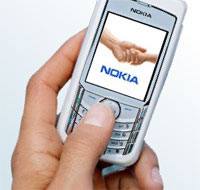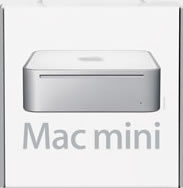 Even the most die-hard Mac hugger is having problems defending the company’s recent litigious spree, where Apple seems determined to become ‘The Man’ and use its corporate power to crush all before it.
Even the most die-hard Mac hugger is having problems defending the company’s recent litigious spree, where Apple seems determined to become ‘The Man’ and use its corporate power to crush all before it.
We find this action particularly strange given the inevitable rise of competition in the portable digital media space. As we’ve saw at CeBIT, the Chinese and Taiwanese MP3-player producing companies have embraced design to good effect. Apple’s iPod crown for the future is now a lot less certain, and given this we’d have thought this would be a time they would be trying to maintain their current friends and make new ones. Instead they appear hell bent on irritating everyone.
First off, there was the case of the bloggers at Apple Insider, PowerPage and Think Secret, mercilessly pursued though the courts after they leaked snippets of Apple’s future plans to their excited audience of Mac users.
Wielding their big white shiny Apple Mac stick, the company successfully won a judgement from the Santa Clara County Superior Court forcing the bloggers to admit to their sources.
The court also granted Apple powers to root around the blogger’s e-mail records in their near-religious quest to track down the culprit.
A wave of international protests followed the ruling by Judge Kleinberg that the laws covering the divulging of trade secrets “outweighed considerations of public interest” with the Guardian newspaper arguing “Was Enron’s off-balance sheet funding structure a “trade secret”, for instance?”
Business Week was equally unimpressed: “Apple has the right to use the legal system to help it punish those who have misappropriated its trade secrets, or to identify employees or partners who may have broken confidentiality agreements.
 But going after the Web sites or forcing them to divulge their sources will put the company in the middle of a freedom-of-speech firestorm that will be a costly distraction for management, and could tarnish the Apple brand.”
But going after the Web sites or forcing them to divulge their sources will put the company in the middle of a freedom-of-speech firestorm that will be a costly distraction for management, and could tarnish the Apple brand.”
Not surprisingly, the EFF was also deeply concerned about the ruling:
“We’re disappointed that the trial court ignored the Supreme Court’s requirement that seeking a journalist’s confidential sources be a ‘last resort’ in civil discovery,” said EFF Staff Attorney Kurt Opsahl. “Instead, the court asserts a wholesale exception to the journalist’s privilege when the information is alleged to be a trade secret.”
“This is a broad-brush ruling that threatens journalists of all stripes,” said EFF Legal Director Cindy Cohn.
Writing in The Scotsman, long time Mac user Stewart Kirkpatrick was equally unchuffed, “In California at least, Apple has destroyed journalism by undermining the most vital tool of our trade: the ability to receive information without having to shop the person who told you.”
Meanwhile, Mac was busy flexing its bully boy corporate muscle in the UK, successfully squashing a smaller company holding prior rights on the iTunes.co.uk domain.
The company registered the name in November 2000 – four years before Apple launched its UK service – with the URL redirecting to their music search engine on CyberBritain.
Apple initiated the complaint because it secretly applied for a UK trademark for the name iTunes on October 27 2000. This application was confidential – known only by Apple, its filing agents and Her Majesty’s Patent Office – and was not published in the TradeMarks Journal until December 6 2000.
After being asked to issue a decision on a complaint through its Dispute Resolution Service, UK domain service registry Nominet has decided that the domain should be handed to Apple.
The owner of iTunes.co.uk, Benjamin Cohen, expressed his frustration. “I must admit that we were not expecting this decision by Nominet’s appointed expert. Apple chose to launch the UK brand of ‘itunes’ within the UK with the knowledge that we had owned the name for three years before their US launch and four years before their launch within the UK,” he said.
“We now face two decisions, whether to appeal to Nominet directly or refer the matter to the High Court. Both of these options are expensive and are not necessarily within the means of a small business. However, the recent High Court victory of Phone4U.co.uk against the major retailer, Phones4U – owned by the Caudwell Group – leads me to think that our case may be extremely strong.”
It’s clear that the Apple self-destruct PR offensive isn’t over yet, with The Register reporting the mysterious case of Google’s vanishing Mac OS X-style interface.
Designed as a tribute to all things Mac, a software engineer had replaced the main text navigation bar on the Google home page with a Mac OS X-style dock sporting a row of eight icons zooming and shrinking as the mouse hovered over them.
The coder was clearly so enamoured with Mac that he included a loving poem above the copyright notice on the Google page: “Roses are red. Violets are blue. OS X rocks. Homage to you”. (sickbag please!)
Sadly, it appears that litigious Apple don’t find anything funny these days, and the design promptly vanished off the Web completely with neither Apple nor Google offering any explanation.
It does seems strange that a company that prides itself for ‘thinking differently’ seems to have embarked on a mission to appear as unpleasant, as ruthless and as willing to crush the little fella as its Redmond neighbours.
With a scathing report in The Guardian concluding that Apple is effectively, “asking to be loathed and subverted”, some pundits are wondering why Apple should actively seek to alienate the people who are its fans and customers.
Put simply, such actions don’t make much business sense.
Google’s X Files disappear
Apple is ‘real loser’ in Think Secret battle
How Apple lost its groove
Nominet backs Apple iTunes domain claim
Blogger lawsuit peels Apple’s shine
 European telco AB has announced that it’s launched the first worldwide free TV station available on 3G mobile phones, via its own TV channel Tango.TV (TTV).
European telco AB has announced that it’s launched the first worldwide free TV station available on 3G mobile phones, via its own TV channel Tango.TV (TTV).![]() We couldn’t work out if this was supposed to be the 3G TV station or not, but after five minutes of looking at a blank screen on our desktop media player, we gave up waiting.
We couldn’t work out if this was supposed to be the 3G TV station or not, but after five minutes of looking at a blank screen on our desktop media player, we gave up waiting. The wires are buzzing with rumours that Barry Diller’s InterActive Corp (IAC) is set to buy the Internet search engine service Ask Jeeves for almost $2bn.
The wires are buzzing with rumours that Barry Diller’s InterActive Corp (IAC) is set to buy the Internet search engine service Ask Jeeves for almost $2bn. We tried to check the story by visiting Ask Jeeves and typing in, “are you being bought by InterActive Corp?”
We tried to check the story by visiting Ask Jeeves and typing in, “are you being bought by InterActive Corp?” The number of wireless Internet users grew by 29% in 2004 according to a recent research study by Ipsos Insight.
The number of wireless Internet users grew by 29% in 2004 according to a recent research study by Ipsos Insight. A similar percentage of users have exchanged digital image and videos over their mobiles.
A similar percentage of users have exchanged digital image and videos over their mobiles. Until now, Apple has been pretty safe in its position of master of all digital music players. That’s lead to speculation of their crown slipping. We’re fresh back from the European consumer show CeBIT and saw many, many good looking, highly functioned, portable music players there.
Until now, Apple has been pretty safe in its position of master of all digital music players. That’s lead to speculation of their crown slipping. We’re fresh back from the European consumer show CeBIT and saw many, many good looking, highly functioned, portable music players there. With a lucrative mobile market hungry for content, it’s not surprising to find a host of companies getting their thinking caps on.
With a lucrative mobile market hungry for content, it’s not surprising to find a host of companies getting their thinking caps on. In addition, the winner and two runner-ups each received filmmaking training courses courtesy of Raindance.
In addition, the winner and two runner-ups each received filmmaking training courses courtesy of Raindance. Internet giants Yahoo are preparing to introduce a new service that blends several of the popular features of its site with two of the Web’s fastest growing activities – blogging and social networking.
Internet giants Yahoo are preparing to introduce a new service that blends several of the popular features of its site with two of the Web’s fastest growing activities – blogging and social networking. Thrill-seeking mobile phone users around the world slapped out US$400 million on pornographic pictures and video in 2004 – an amount that is expected to rise to US$5 billion by 2010, according to a report by research group Strategy Analytics.
Thrill-seeking mobile phone users around the world slapped out US$400 million on pornographic pictures and video in 2004 – an amount that is expected to rise to US$5 billion by 2010, according to a report by research group Strategy Analytics. The US$5 billion forecast for 2010 represents a huge upward shift from Strategy Analytics’ earlier predictions, with the company noting that adult entertainment businesses are aggressively building services and customers appear happy to shell out for them.
The US$5 billion forecast for 2010 represents a huge upward shift from Strategy Analytics’ earlier predictions, with the company noting that adult entertainment businesses are aggressively building services and customers appear happy to shell out for them. Even the most die-hard Mac hugger is having problems defending the company’s recent litigious spree, where Apple seems determined to become ‘The Man’ and use its corporate power to crush all before it.
Even the most die-hard Mac hugger is having problems defending the company’s recent litigious spree, where Apple seems determined to become ‘The Man’ and use its corporate power to crush all before it. But going after the Web sites or forcing them to divulge their sources will put the company in the middle of a freedom-of-speech firestorm that will be a costly distraction for management, and could tarnish the Apple brand.”
But going after the Web sites or forcing them to divulge their sources will put the company in the middle of a freedom-of-speech firestorm that will be a costly distraction for management, and could tarnish the Apple brand.” MP3 playing device includes software for sending and receiving Internet-based phone calls.
MP3 playing device includes software for sending and receiving Internet-based phone calls. Ezmax demonstrated the device at their stand at CeBIT, plugging the player into a notebook PC and successfully making a call via the VoIP dialling software.
Ezmax demonstrated the device at their stand at CeBIT, plugging the player into a notebook PC and successfully making a call via the VoIP dialling software. In addition, the device is capable of voice recording and sports a two-colour (blue and yellow) 128 pixel by 64 pixel OLED screen.
In addition, the device is capable of voice recording and sports a two-colour (blue and yellow) 128 pixel by 64 pixel OLED screen. Shipments of MP3 players soared by an enormous 116% in 2004, as hundreds of wallet-tempting products arrived in response to the phenomenal success of Apple iPod player, according to a survey by Market Intelligence firm, iSuppli.
Shipments of MP3 players soared by an enormous 116% in 2004, as hundreds of wallet-tempting products arrived in response to the phenomenal success of Apple iPod player, according to a survey by Market Intelligence firm, iSuppli. The iSuppli report also predicts that HDD-based MP3 player shipments will grow by a CAGR of 41.8% from 2004 to 2009, as compared to 22.9% for flash-based players.
The iSuppli report also predicts that HDD-based MP3 player shipments will grow by a CAGR of 41.8% from 2004 to 2009, as compared to 22.9% for flash-based players.